
Photographs by Nate Palmer
This article was featured in One Story to Read Today, a newsletter in which our editors recommend a single must-read from The Atlantic, Monday through Friday. Sign up for it here.
My stepdad, Obbie Riley, was born in Philadelphia, Mississippi, a place known nationally more for an act of unspeakable violence than for anything else. He turned 2 during the Freedom Summer of 1964, when nearly 1,000 volunteers from up north worked alongside local activists registering Black Mississippians to vote. A week into the project, Klansmen murdered three young civil-rights workers—James Chaney, Andrew Goodman, and Michael Schwerner—who had come to investigate the Ku Klux Klan’s burning of Mount Zion United Methodist Church, where my stepdad grew up worshipping. The violence stuck with him. He left the state after high school to look for work, but 22 years later he returned to his hometown, with history still on his mind.
Now my stepfather is one of a handful of Black folks around town who give informal tours of Philadelphia’s civil-rights history. The pandemic put these tours on hold for a while, but even before COVID, they were irregular, and could be found only by word of mouth. Guides like Obbie don’t have websites, or even Facebook pages. Yet people from all over have managed to reach them—Obbie estimates that he’s given more than 100 tours. Their popularity is understandable in a town where official sources, such as the local museum, are still reluctant to tell the story. Even in this boom time of national memorialization of Black civil-rights history, in Philadelphia, tours like Obbie Riley’s are the only real way to connect to the dark truth of our past.
This fall, on one of my trips back home, I decided to talk with him about that past. I sat at the kitchen counter as he washed dishes. He told me he’s curious about what people—white people—think about the 1964 murders. Obbie, who also serves on the county’s board of supervisors as the only Black person and sole Democrat, has spent his life capturing memories about that time from his elders. He’s inclined to assume that the legacy of the murders doesn’t affect the white population, which makes up about 60 percent of the county, as much as it does the Black folks. But he doesn’t know for sure. No one talks about it, after all.
“I think they made themselves believe that sticking their heads in the ground is a cure,” he said. “We haven’t opened up and talked about it to heal.”
Obbie told me he started doing tours years ago. What happened here is no secret—there are books and movies about it. People who cared about civil-rights history would travel to the church in June for the annual memorial service to commemorate the three civil-rights workers, and many would ask to get better acquainted with the history. Obbie is of the opinion that if something needs to get done, especially something as important as ensuring that the legacy of your community and family doesn’t get erased, you’d better first employ yourself to do something about it. I’d lived in town for years, but I’d never taken his tour. So on a chilly November day, we hopped into his white pickup truck at dusk with his mean little mutt, Rex. We pulled out of the long gravel driveway and drove into history.
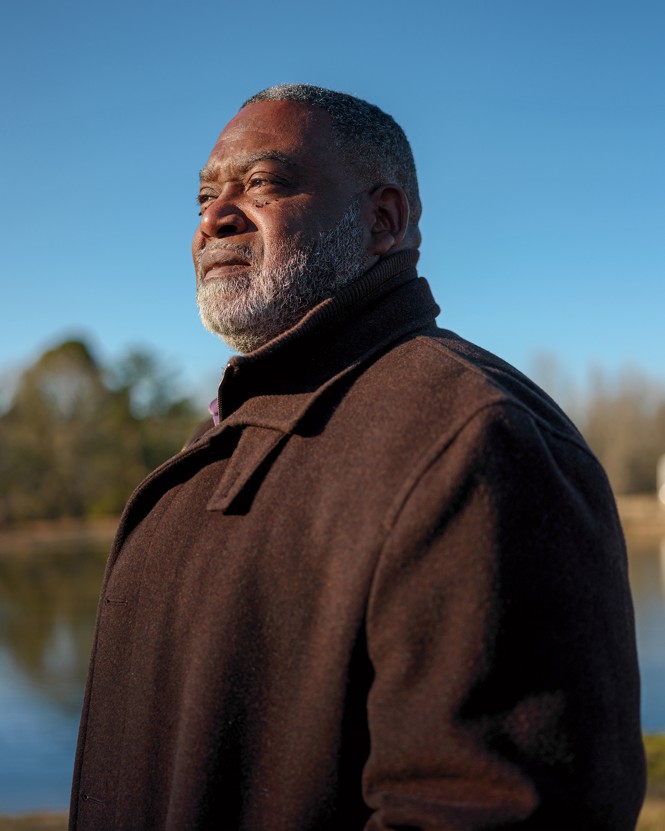
We began in the woods about half a mile up the road from my parents’ house. Obbie showed me the 200-year-old post-oak trees that he said mark where sharecroppers like his parents lived in tenant houses, and the woodsy, overgrown area where, he told me, formerly enslaved people are buried, their markers missing or mossy and tilted. We turned down Road 747, where a white sign at the highway intersection advertises Mount Zion, just about two or so miles down this country road.
The red-brick building sits a ways back from the road, accessible by a semicircle driveway. Six decades ago, the Klan ambushed Black churchgoers here as they left a meeting.
The Klan had been monitoring 24-year-old Michael Schwerner, a Jewish civil-rights worker originally from New York who was on staff at the Congress of Racial Equality (CORE), one of the civil-rights groups that had come together as the Council of Federated Organizations (COFO) to organize Freedom Summer. Schwerner had opened the COFO field office in nearby Meridian, and led the office with his wife, Rita. He was also leading the effort to turn Mount Zion into a Freedom School—a center to help the surrounding community combat voter-suppression tactics. Places like Mount Zion—Black churches in Black communities—were the only spaces where the activists could hope to have any safety. But on that June night, Klansmen came to Mount Zion after getting a tip that a meeting was happening at the church, and that Schwerner and other white civil-rights workers might be there. They weren’t—but Klan members still exacted violence on the church’s parishioners.
[Read: Ending 50 years of silence about Mississippi’s Freedom Summer]
One man, Bud Cole, suffered a beating so brutal that he walked with a limp for the rest of his life. Georgia Rush and one of her sons, John Thomas, were also beaten. Klansmen returned later that night and set fire to Mount Zion, burning it down completely. A report from the Associated Press said Mount Zion was one of four “Negro” churches scorched in Mississippi within a 10-day period.
Word about Mount Zion’s destruction traveled to a Freedom Summer training Schwerner was helping conduct at Western College for Women, in Ohio (now Miami University). Schwerner knew he had to head back to Philadelphia. So did James Chaney, a Black CORE staffer and native of Meridian who’d been working with Schwerner that summer. A new volunteer named Andrew Goodman, a Jewish college student who was also from New York, asked to go too. Later, the FBI would come to believe that the Klan had burned Mount Zion to lure Schwerner back.
Schwerner, Chaney, and Goodman arrived in Philadelphia on June 21, five days after the fire, to interview community members. One of the last places they stopped was Rush’s home, to pay their respects. The three men knew they had to get out of Neshoba County before nightfall. An agency called the Mississippi State Sovereignty Commission had been tracking civil-rights workers and had given the Neshoba County Sheriff’s Office—and thus the Klan—a description of the car the men were driving.
The way my stepdad tells it is that, after leaving Rush’s residence, Chaney, Goodman, and Schwerner decided to drive through town to catch Highway 19 to Meridian and avoid the winding back roads. From this point, the details diverge depending on whose version of events you hear. According to FBI documents, Deputy Sheriff Cecil Ray Price, a Klansman, spotted their station wagon while he was driving in the opposite direction; he turned around and began following it. In the center of town, the men pulled over to change a tire. Price pulled up beside them. He let them fix their car before arresting them and taking them to the county jail, booking Chaney for speeding and holding Schwerner and Goodman for investigation. While they were locked up, Price called Edgar Ray Killen, a local preacher and Klansman, to alert him to the young men’s capture.
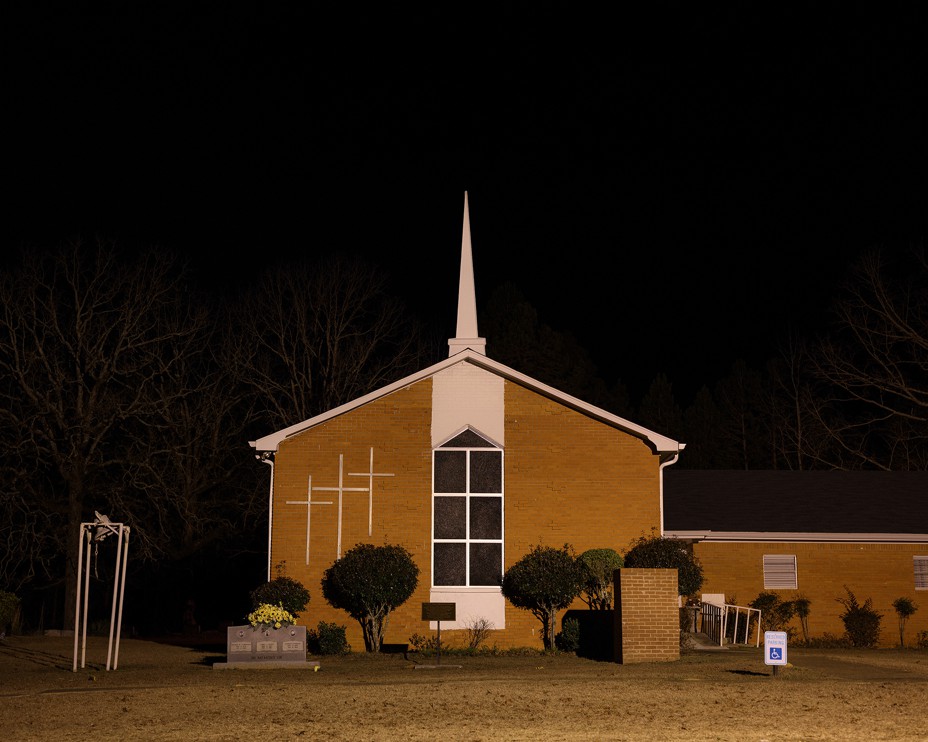
Obbie made that turn onto Highway 19, close to where Price had apprehended the trio. We proceeded down the two-lane road, a stretch of which has been renamed Goodman Chaney Schwerner Memorial Highway. It’s the road they drove down after Price released them from jail at about 10:30 p.m.
Less than 10 miles down the road is the marker for an area called Bethsaida, home to a suspected Klan meeting spot at the time. My stepdad floored the gas pedal. “This is where the chase began,” he told me.
Two cars of Klansmen had been following the station wagon. They were soon joined by Price. It was Price who pulled up behind the three civil-rights workers, in his patrol car. Obbie said he wonders what the trio’s conversation must have been, what they must have said to one another once they realized they were being pursued. The men pulled over and Price forced them into his patrol car; another Klansman took the wheel of the station wagon. The cars drove together to a secluded spot on Rock Cut Road.
There are different versions of what happened next. According to a confession later made by one of the Klansmen, his partners pulled Schwerner from the car and shot him first, then Goodman. A private autopsy performed later indicated that the Klansmen had beaten Chaney severely before they killed him. The man who shot Chaney complained that he hadn’t gotten to kill one of the white men: “You didn’t leave anything but a nigger.” Then the Klansmen loaded the bodies back into the station wagon and drove away.
The disappearance of the civil-rights workers created a national uproar. As the federal government launched a massive 44-day manhunt, Rita Schwerner, Michael’s widow, said that the reason the widespread search was happening at all was because two of the three men were white. Two days after they were killed, authorities found their torched station wagon in Bogue Chitto Creek. As law-enforcement and military officials searched the surrounding area for the three victims, they came across the bodies of two Black men who had gone missing earlier that year. Federal agents ultimately found the three bodies they were looking for on Old Jolly Farm, buried in an earthen dam.
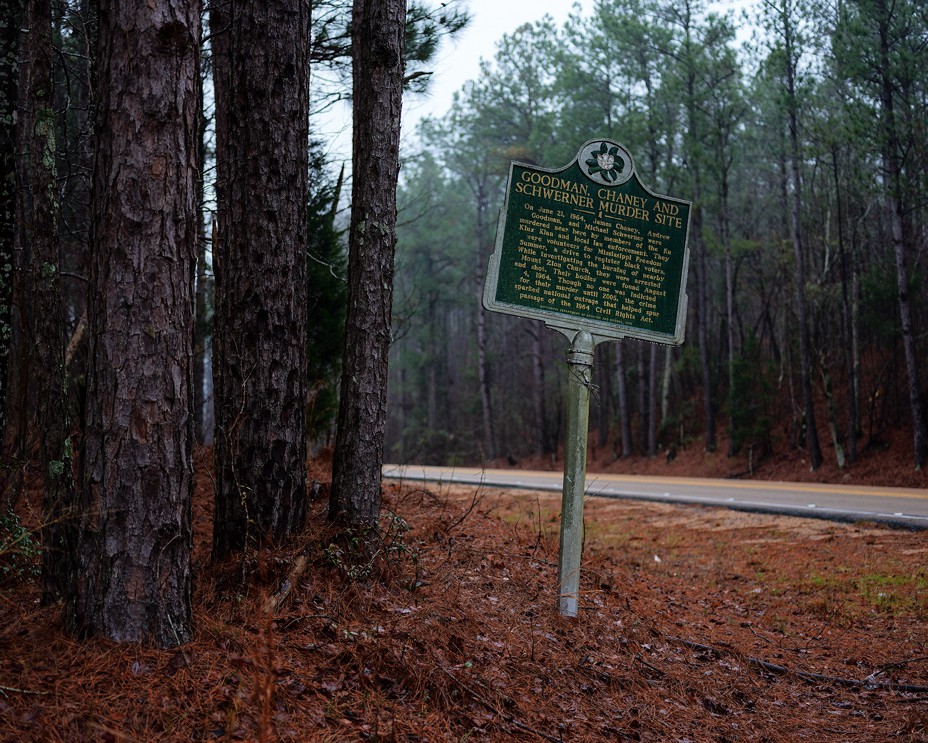
It’s perfectly possible to come to Philadelphia, Mississippi, without ever encountering this history.
A few weeks before I went on the tour with my stepfather, I visited the Philadelphia–Neshoba County Historical Museum, a white wooden house off a narrow street that dead-ends in the woods. I had heard there was nothing in the museum about Mount Zion or the three civil-rights workers, and wanted to see for myself.
The museum manages to be both in the center of town and tucked away, and has been open since the ’90s. One day last fall, I finally succeeded at getting inside—the hours of operation are a mere suggestion. I rang the bell and a volunteer, an older white woman, came to greet me. She offered a tour.
For about half an hour, she walked me through the exhibits that detailed what downtown social life was like in the 1920s. An entire room on the first floor is dedicated to the country-music star and Philadelphia native Marty Stuart. Across from Stuart’s room is another music-centered room, dedicated to Otis Rush and Foots Baxstrum, whose histories have been given a wall apiece. We trekked upstairs to the veterans’ memorial, in a dusty room that felt like an attic.
Our final stop was a replica cabin of the kind you see at “Mississippi’s Giant Houseparty,” the Neshoba County Fair. The event is an annual week of horse racing, politicking, beer chugging, and whiteness. The fair was where Ronald Reagan launched his presidential campaign with a speech about states’ rights, a loud dog whistle not far in distance or time from the Freedom Summer murders. It’s the town’s pride, and part of the reason Philadelphia’s tagline is “Our fair city.”
[From the KING issue: Jesmyn Ward on how racism is “built into the very bones” of Mississippi]
At the end of the tour, I asked my guide if maybe I had missed the Mount Zion exhibit. “This is supposed to be back before the ’60s, you know, and all that happened in the ’60s,” she said. “We don’t have anything on that.”
We stood in silence.
A museum board member later confirmed that it doesn’t have anything on Mount Zion or the murders, and that curators focus on the agricultural and industrial history of the county, not social justice or race. “We stay away from issues that would be controversial,” he said.
If you want to find out what happened here and aren’t related to a tour guide, you might start at the Depot, a former train station that’s now home to several municipal offices, including the tourism bureau.
At the main entrance, a volunteer told me that guided civil-rights tours weren’t being offered during the pandemic and that she didn’t know who normally organized them. So I visited Tim Moore’s office, just down the hall. Moore, 46, runs the Community Development Partnership, which is responsible for tourism in the city and the county. Moore told me that he’s often the middleman connecting visitors who call ahead with guides like Obbie. Like many white people his age, Moore didn’t learn about the history of Mount Zion until he was an adult. He said he has reservations about his office taking on more responsibility when it comes to formalizing the civil-rights tours. “Yes, we’re all in the same community; it’s all of our story,” he told me. “But I never want to infringe on that particular story, because it is sacred. It is special.” He sticks to arranging tours on a case-by-case basis.
In addition to my stepdad, one of the people Moore often calls is Jewel McDonald, the daughter of Georgia Rush, the woman who was beaten in the attack on Mount Zion in 1964. McDonald turned 18 six days before the Klan burned down her church. She was supposed to be in the sanctuary that night, but she had decided to watch her niece instead. Now 75 years old, she’s become another unofficial docent on the civil-rights trail here. She gave tours until the pandemic began, especially to students, and plans to start again when she can. It’s not as easy for her as it once was—in 2010, McDonald lost her right leg to a bacterial infection. But she does it anyway.
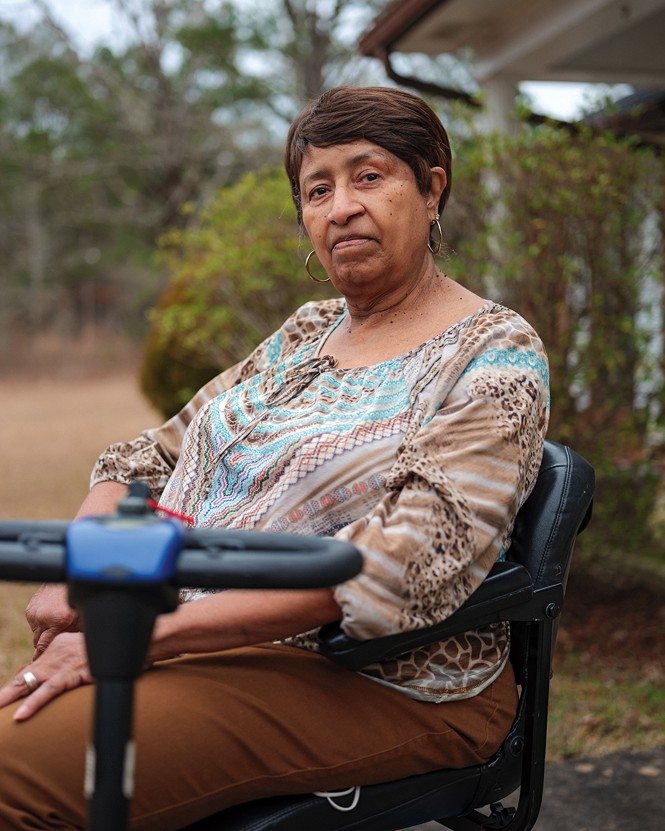
“What’s done in the dark always comes to the light,” McDonald told me one Sunday afternoon while we sat at her kitchen table. It’s a refrain she often heard from her mother.
Five months after the murders, McDonald married her husband, Cleo. They caught the Greyhound bus headed north the next day. The McDonalds first lived in Syracuse, New York, and then Cleveland, places where they had some family. Jewel thought she might never come back to Mississippi. When Cleo popped into the kitchen, he told me that it was always in the plan to return. “I told you that before we got married,” Cleo said to Jewel. They came back in 1994, to move Jewel’s mom home to Mississippi after she’d fallen ill.
About a decade after the McDonalds returned, Jewel got a phone call from Jim Prince, the editor and publisher of the local newspaper, inviting her to a meeting regarding the upcoming 40th anniversary of the murders. The multiracial group of residents who attended that meeting continued to meet regularly afterward. Accountability for the crimes had been minimal. A federal trial in 1967 resulted in seven convictions, eight not-guilty verdicts, and three mistrials. But the 18 defendants had been charged with civil-rights violations, not murder. Only the state government could have brought murder charges, and Mississippi had not pursued the case. None of the defendants served more than six years in prison.
[Read: Nikole Hannah-Jones on Freedom Summer, 1964—did it really change Mississippi?]
It had been an open secret that the Klansman and Baptist preacher Edgar Ray Killen had played a significant role in the murders. In 1967, he was one of the 11 men who got off scot-free; a woman on the all-white jury said she couldn’t bring herself to convict a preacher. In 2004, he was still alive, and living nearby.
For months, the group Prince helped organize, which became known as the Philadelphia Coalition, listened to stories of residents like Jewel, who told them about how her mother and brother were beaten. On May 26, 2004, the coalition made a public appeal at city hall for the state to level criminal charges. Leroy Clemons, then the president of the local NAACP chapter and also a tour guide, read the announcement with Prince, his fellow coalition chair. The remarks didn’t directly name whom the state might charge with murder, but everyone knew they referred to Killen.
[From the September 2021 issue: What we still don’t know about Emmett Till’s murder]
“We deplore the possibility that history will record that the state of Mississippi, and this community in particular, did not make a good-faith effort to do its duty,” Clemons said.
The coalition’s efforts paid off. In June 2005, Killen was finally prosecuted by the state of Mississippi. He was sentenced to 60 years in prison for manslaughter; he died just shy of his 93rd birthday while incarcerated at Parchman, the state penitentiary.
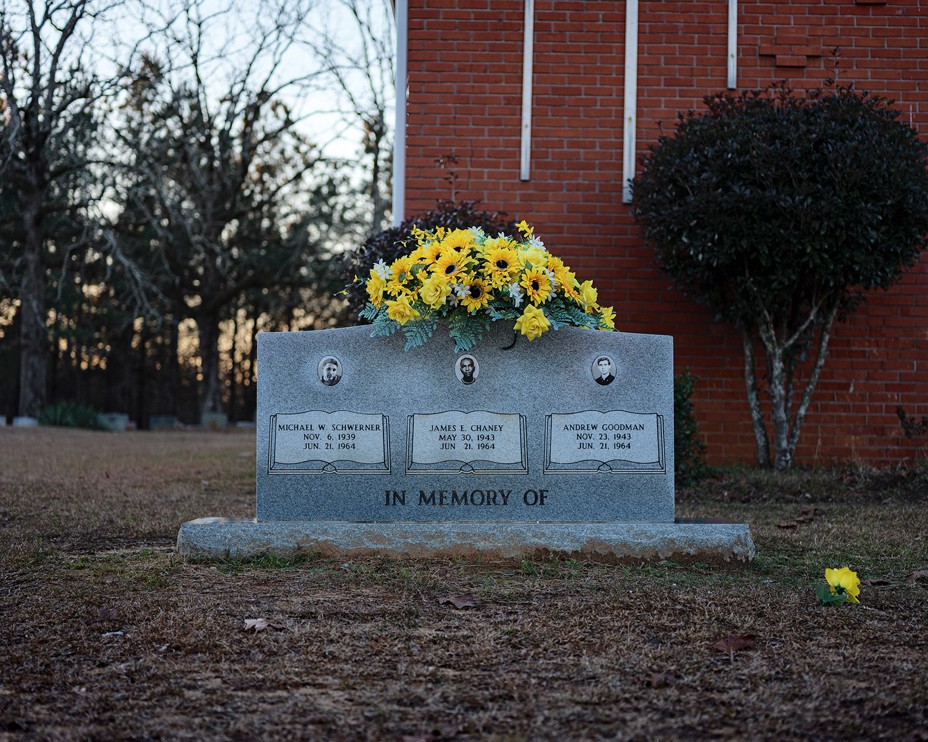
Jewel began giving tours around the time of the trial that put Killen away. She told me that when she was living up north, she never talked about what had happened in 1964—no one did. But she was upset to encounter a veil of silence in Philadelphia shrouding the history of “the boys,” as many in her generation call the trio. She saw a need, both for the kids in the area who weren’t learning this history in school—and whose grandparents might have still been afraid to talk, Jewel added—and for the out-of-towners who would come by the church and elsewhere asking for a tour.
But the lack of infrastructure also meant that, for years, Jewel wasn’t paid for her time, beyond voluntary donations. Only recently has she begun charging a small fee. It also means you can come to Neshoba County, or grow up in it for that matter, without ever getting a good account of what happened here.
I can understand why people don’t want to talk about this history. It’s disturbing and painful, as the truth can be. Learning this history is like taking bitter medicine, my stepdad said. “If you never cleanse yourself of this and own it,” he continued, “it’s just there.”
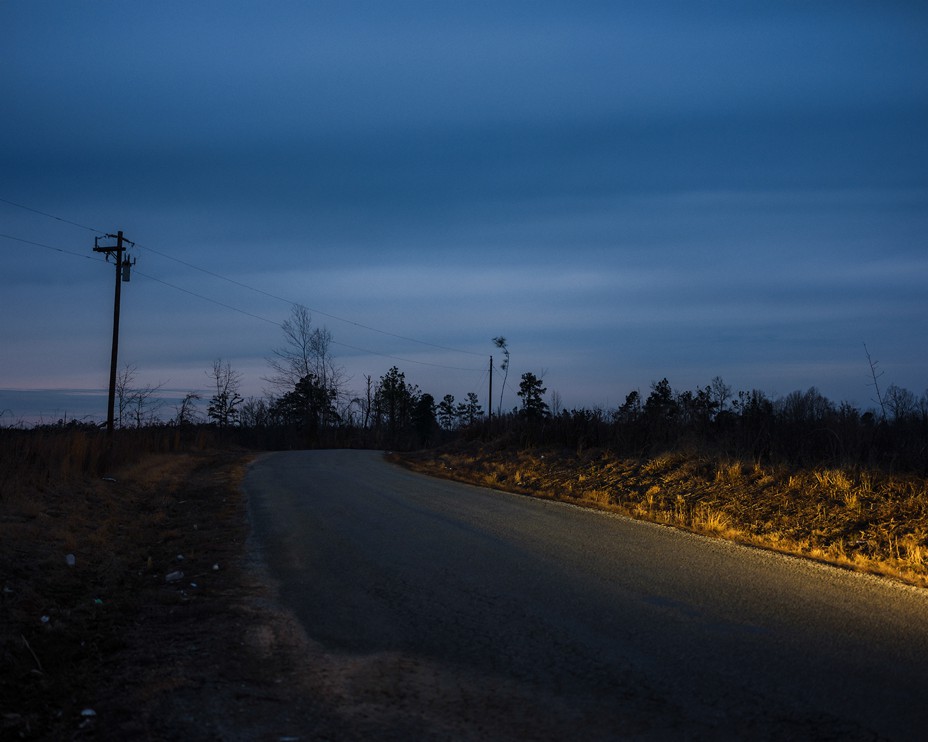
But despite the silence in Neshoba County, the markers of this history are all around, if you know where to look. They’re in church cemeteries and in the stories passed down—the ghosts that appear to haunt only some of us. Especially during these past two years of the pandemic, when gathering with elders has been tricky at best, I’ve been anxious about all of the memories, histories, and knowledge we stand to lose. They are the stewards of this nation’s civil rights, and I fear that our history might die with them.
Lately, a remedy for this worry has been to turn on a recorder when Obbie gets to telling a story, or when he’s with his brothers, or when my great-aunt recalls what it was like to leave Mississippi for Chicago only to come back home. I realize that my own efforts to chronicle their stories are attempts at picking up reins that they will soon cease to hold. I understand that history is not just forgotten—rather, it is destroyed by the same violence that claimed Mount Zion. As Martin Luther King Jr. said on his visit to the ruins in 1964: “I think this church was burned because it took a stand.” But the target was never just a building.
This article appears in the May 2022 print edition with the headline “Tour Guides to a Tragedy.” When you buy a book using a link on this page, we receive a commission. Thank you for supporting The Atlantic.







